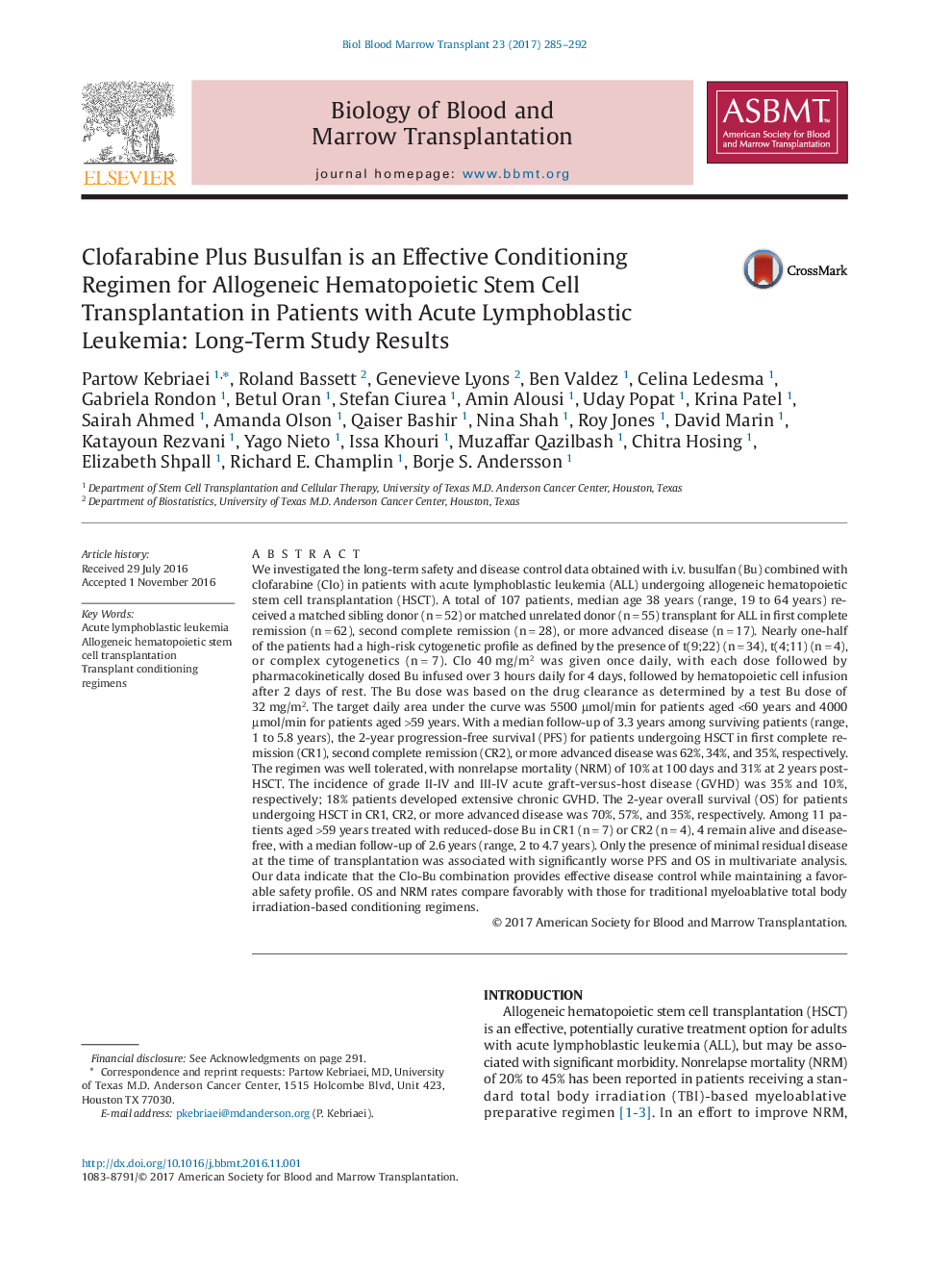| کد مقاله | کد نشریه | سال انتشار | مقاله انگلیسی | نسخه تمام متن |
|---|---|---|---|---|
| 5524248 | 1546245 | 2017 | 8 صفحه PDF | دانلود رایگان |
- Long-term outcomes with use of a radiation-free hematopoietic stem cell transplantation (HSCT) conditioning regimen for acute lymphoblastic leukemia (ALL) were analyzed.
- Results were comparable to those for radiation-containing regimens.
- Myeloablative clofarabine plus busulfan is an effective HSCT regimen for adult ALL.
We investigated the long-term safety and disease control data obtained with i.v. busulfan (Bu) combined with clofarabine (Clo) in patients with acute lymphoblastic leukemia (ALL) undergoing allogeneic hematopoietic stem cell transplantation (HSCT). A total of 107 patients, median age 38 years (range, 19 to 64 years) received a matched sibling donor (nâ=â52) or matched unrelated donor (nâ=â55) transplant for ALL in first complete remission (nâ=â62), second complete remission (nâ=â28), or more advanced disease (nâ=â17). Nearly one-half of the patients had a high-risk cytogenetic profile as defined by the presence of t(9;22) (nâ=â34), t(4;11) (nâ=â4), or complex cytogenetics (nâ=â7). Clo 40âmg/m2 was given once daily, with each dose followed by pharmacokinetically dosed Bu infused over 3 hours daily for 4 days, followed by hematopoietic cell infusion after 2 days of rest. The Bu dose was based on the drug clearance as determined by a test Bu dose of 32âmg/m2. The target daily area under the curve was 5500 µmol/min for patients aged <60 years and 4000 µmol/min for patients aged >59 years. With a median follow-up of 3.3 years among surviving patients (range, 1 to 5.8 years), the 2-year progression-free survival (PFS) for patients undergoing HSCT in first complete remission (CR1), second complete remission (CR2), or more advanced disease was 62%, 34%, and 35%, respectively. The regimen was well tolerated, with nonrelapse mortality (NRM) of 10% at 100 days and 31% at 2 years post-HSCT. The incidence of grade II-IV and III-IV acute graft-versus-host disease (GVHD) was 35% and 10%, respectively; 18% patients developed extensive chronic GVHD. The 2-year overall survival (OS) for patients undergoing HSCT in CR1, CR2, or more advanced disease was 70%, 57%, and 35%, respectively. Among 11 patients aged >59 years treated with reduced-dose Bu in CR1 (nâ=â7) or CR2 (nâ=â4), 4 remain alive and disease-free, with a median follow-up of 2.6 years (range, 2 to 4.7 years). Only the presence of minimal residual disease at the time of transplantation was associated with significantly worse PFS and OS in multivariate analysis. Our data indicate that the Clo-Bu combination provides effective disease control while maintaining a favorable safety profile. OS and NRM rates compare favorably with those for traditional myeloablative total body irradiation-based conditioning regimens.
Journal: Biology of Blood and Marrow Transplantation - Volume 23, Issue 2, February 2017, Pages 285-292
